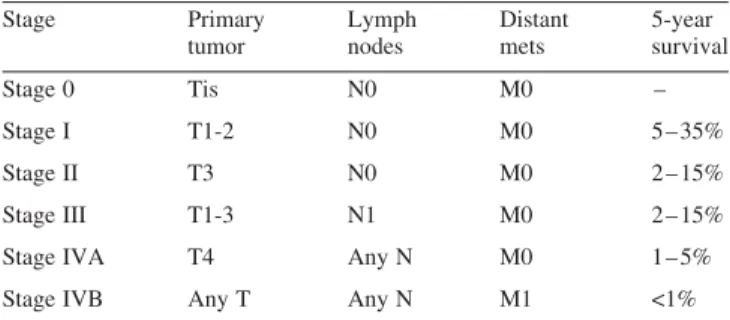ESMO Minimum Clinical Recommendations for diagnosis,
treatment and follow-up of pancreatic cancer
Incidence
. The crude incidence and mortality of pancreatic cancer in the European Union is about 11/100 000 per year. In around 5% of patients some genetic basis for the disease can be found.
Diagnosis
. Pathological diagnosis should be made according to the World Health Organisation classification from a biopsy or fine needle aspiration. Ductal adenocarcinomas constitute 95% of the epithelial tumors.
Staging and risk assessment
. Staging consists of complete history and physical
examin-ation, blood counts, liver enzymes, chest X-ray, imaging of the abdomen by sonography and CT scan or magnetic resonance, and possibly by endosonography.
. Patients with pancreatic cancer may be staged according to
the TNM system and can be grouped as in Table 1.
. However, the distinction of whether or not a tumor remains resectable is not well reflected in the TNM system and survival is more dependent on age than on TNM stage, as demonstrated by the wide range of survival figures given for each stage.
. Evaluation of resectability often requires surgery, preferably by staging laparoscopy to exclude clinically occult intra-abdominal and lymph node metastases.
. To be resectable, tumors must show no evidence of
extra-pancreatic disease or direct tumor extension to the celiac axis and superior mesenteric artery nor evidence of non-obstructive invasion of the superior mesenteric-portal vein confluence.
. Less than 20% of all patients have resectable disease.
Treatment of resectable tumors
. Complete surgical resection is the only potentially curative treatment available. However, five-year overall survival is only 10 – 20%. Long-term survival in N+ tumors is rare.
. Preoperative or postoperative chemotherapy with or without radiotherapy remains controversial.
Treatment of locally advanced or metastatic
disease
. Optimal symptomatic treatment has a prime role in the man-agement of metastastic disease. This may require stenting or
bypass surgery for obstructive jaundice or gastric outlet obstruction.
. The role of chemotherapy is limited. Gemcitabine has been associated with a small survival benefit compared with bolus 5-fluorouracil [II, B].
Response evaluation
. Objective response evaluation by the initial radiographic test may not be necessary for adequate patient management. Evaluation of response should be symptom-driven.
Follow-up
. Due to the limited effectiveness of treatments follow up after complete resection should be restricted to history and physical examination.
Note
Levels of Evidence [I – V] and Grades of Recommendation [A – D] as used by the American Society of Clinical Oncology are given in square brackets. Statements without grading were considered justified standard clinical practice by the experts and the ESMO faculty.
Literature
1. Burris HA, Moore MJ, Andersen J et al. Improvements in survival and clinical benefit with gemcitabine as first-line therapy for patients with advanced pancreatic cancer: a randomized trial. J Clin Oncol 1997; 15: 2403 – 2413.
2. John TG, Greig JD, Carter DC et al. Carcinoma of the pancreatic head and periampullary region. Tumor staging with laparoscopy and laparoscopic ultrasonography. Ann Surg 1995; 221: 156 – 164. 3. National Comprehensive Cancer Network: http://www.nccn.org(date
last accessed, 26 February 2005). Table 1. Stage Primary tumor Lymph nodes Distant mets 5-year survival Stage 0 Tis N0 M0 – Stage I T1-2 N0 M0 5 – 35% Stage II T3 N0 M0 2 – 15% Stage III T1-3 N1 M0 2 – 15% Stage IVA T4 Any N M0 1 – 5% Stage IVB Any T Any N M1 <1%
Annals of Oncology 16 (Supplement 1): i24 – i25, 2005 doi:10.1093/annonc/mdi824
4. Klinkenbijl JH, Jeekel J, Sahmoud T et al. Adjuvant radiotherapy and 5-fluorouracil after curative resection of cancer of the pancreas and periampullary region: phase III trial of the EORTC gastrointestinal tract cancer cooperative group. Ann Surg 1999; 230: 776 – 782. 5. Neoptolemos JP, Stocken DD, Friess H et al. A randomized trial of
chemoradiotherapy and chemotherapy after resection of pancreatic cancer. N Engl J Med 2004; 350: 1200 – 1210.
6. Neoptolemos JP, Stocken DD, Dunn JA et al. Influence of resection margins on survival for patients with pancreatic cancer treated by adjuvant chemoradiation and/or chemotherapy in the ESPAC-1 ran-domized controlled trial. Ann Surg 2001; 234: 758 – 768.
Coordinating authors for the ESMO Guidelines Task Force: R. Herrmann1,
L. M. Jost2& N. Pavlidis3
1
Invited author, Oncology, University Hospital, CH-4031 Basel, Switzerland;2Invited author and member of the task force, Oncology,
Kantonsspital, CH-4101 Bruderholz / BL, Switzerland;3Assigned task force member, University of Ioannina, Dept. Medical Oncology, 45110 Ioannina, Greece
Approved by the ESMO Guidelines Task Force: August 2003, last update December 2004.
Correspondence to: ESMO Guidelines Task Force ESMO Head Office
Via La Santa 7 CH-6962 Lugano Switzerland
